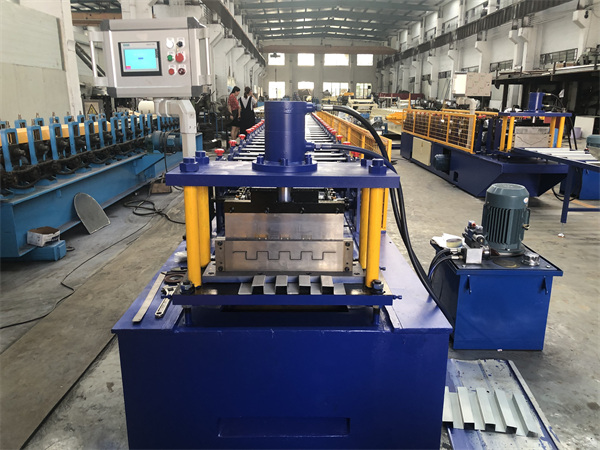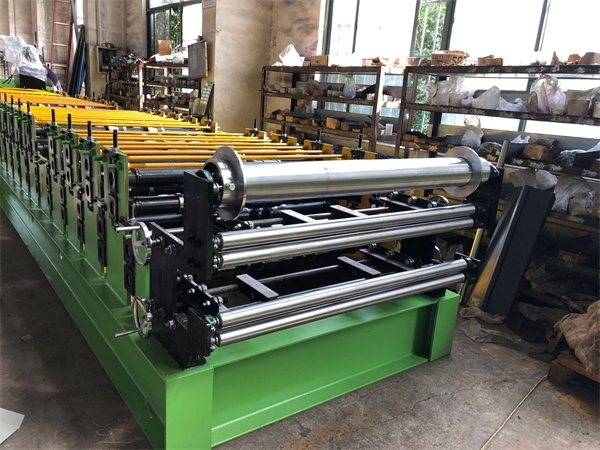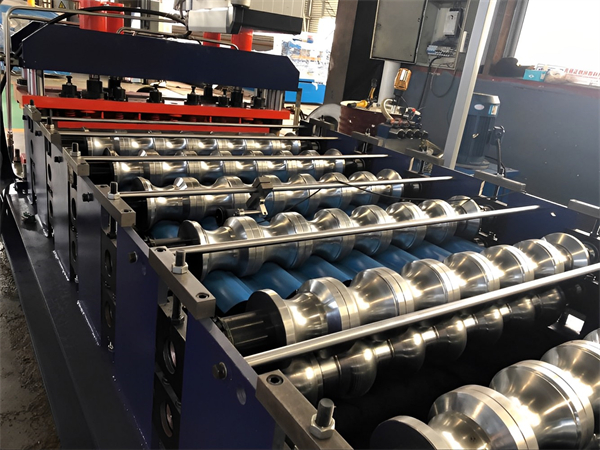Mesin pembuat gulungan otomatis digunakan untuk terus menerus membengkokkan dan membentuk gulungan logam menjadi profil dan bentuk penampang yang disesuaikan. Proses otomatis yang efisien ini sangat ideal untuk produksi komponen logam dalam jumlah besar seperti panel atap, kusen pintu, sistem rak, pagar jalan raya, rangka panel surya, dll.
Komponen yang dibentuk dengan roll memiliki akurasi dan konsistensi dimensi yang tinggi dibandingkan dengan metode pembengkokan lainnya. Fleksibilitas roll forming memungkinkan produksi profil yang kompleks dengan lebih cepat dan lebih murah daripada fabrikasi atau ekstrusi. Hal ini membuatnya populer untuk berbagai aplikasi di bidang infrastruktur, konstruksi, otomotif, pertanian, pengemasan, dan industri lainnya.
Panduan ini mencakup semua yang perlu Anda ketahui tentang teknologi roll forming otomatis - prinsip kerja, klasifikasi, komponen utama, pertimbangan desain, spesifikasi, aplikasi, keunggulan, keterbatasan, dan banyak lagi.
Jenis Mesin Roll Forming Otomatis
Ada dua kategori utama mesin roll forming otomatis:
Mesin Roll Forming Berkelanjutan
Mesin ini menghasilkan profil yang panjang secara terus menerus dari gulungan lembaran logam. Proses uncoiling, feeding, bending, dan cutting terintegrasi secara in-line untuk efisiensi yang tak tertandingi.
Mesin Pembentuk Gulungan Langkah
Ini beroperasi secara terputus-putus, membentuk satu bagian diskrit pada satu waktu dari strip logam. Setiap langkah secara berurutan membengkokkan material secara bertahap hingga terbentuk.
Pembentukan gulungan kontinu secara signifikan lebih cepat dengan kecepatan lebih dari 100 kaki/menit. Mesin step memiliki kecepatan maksimal sekitar 16 kaki/menit tetapi menawarkan fleksibilitas yang lebih tinggi untuk proses produksi yang singkat.
| Jenis Mesin Roll Forming | Karakteristik |
|---|---|
| Berkelanjutan | Kecepatan tinggi hingga 130 kaki/menit |
| Pembentukan in-line yang terintegrasi | |
| Volume produksi yang besar | |
| Langkah | Kecepatan lebih lambat 10-16 kaki/menit |
| Pembengkokan berurutan per langkah | |
| Lari pendek atau terputus-putus |
Klasifikasi Berdasarkan Bentuk Struktural yang Terbentuk
Mesin roll forming otomatis dapat dikelompokkan berdasarkan jenis bagian struktural yang diproduksi:
- Pembentukan Lembaran & Panel Roll Forming - Untuk bagian planar datar seperti lembaran atap, pintu garasi, dinding samping trailer
- Pembentuk Gulungan Decking - Penghiasan logam bergelombang untuk lantai, jembatan, mezanin
- Pembentukan Gulungan Saluran C & U - Profil berongga cee dan persegi panjang seperti pembatas jalan
- Pembentukan Gulungan Sudut - Bagian sudut berbentuk L untuk rak, rak, bingkai
- Pembentukan Gulungan Saluran Topi - Balok berbentuk topi untuk dinding, kancing logam
- Pembentukan Gulungan Kelongsong - Pelapis fasad arsitektur, panel dinding
- Pembentukan Kusen Pintu Roll Forming - Kusen pintu dan jendela berongga
- Pembentukan Gulungan Balok Baja - Balok-I, balok-H
- Tabung Persegi / Persegi Panjang - Bagian struktur berongga sebagai kolom, tiang pagar
- Bentuk Khusus - Profil khusus untuk aplikasi khusus
Klasifikasi berdasarkan Industri
Sistem roll forming otomatis melayani berbagai macam industri:
- Konstruksi: Panel dinding, atap, bingkai, jendela
- Infrastruktur: Rel jalan raya, tiang penerangan, drainase
- Otomotif: Bagian sasis, panel, bumper
- Pertanian: Silo, rumah kaca, kandang ternak
- Transportasi: Badan truk, trailer, gerbong kereta api
- Pengemasan: Rak, rak, palet, konveyor
- Furnitur: Penyimpanan, tampilan, bingkai
- HVAC: Ducting
- Peralatan: Mesin cuci, lemari es
Penerapan yang luas ini membuat roll forming menjadi proses pengerjaan logam yang serbaguna.

Komponen Utama Mesin Roll Forming Otomatis
Jalur roll forming otomatis yang khas terdiri dari beberapa komponen modular:
Uncoiler
Uncoiler memegang kumparan besar dari lembaran logam melingkar tipis yang dipasang pada poros. Ini dengan mantap melepaskan strip di ujung masuk.
pengumpan
Pengumpan terdiri dari rol penjepit bertenaga yang mencengkeram strip dan menariknya melalui saluran dengan kecepatan konstan.
Unit Pra-pukulan
Kepala pelubang pneumatik opsional untuk melubangi atau memotong strip sebelum dibentuk.
Rol Listrik Servo
Stasiun penggulungan dengan rol atas dan bawah membengkokkan strip secara bertahap saat melewatinya. Motor servo secara tepat mengontrol gerakan rol.
Sistem Hidraulik
Hidraulik menaikkan/menurunkan rol untuk pergantian alat yang cepat di antara profil yang berbeda.
Pengontrol
Kontrol PLC mengoordinasikan semua gerakan alat berat dan melacak posisi strip.
Decoiler / Recoiler
Memutar kembali profil yang sudah jadi dengan rapi atau memotong sesuai panjang yang diperlukan.
Kandang Pengaman
Penjagaan perimeter penuh untuk keselamatan operator.
Opsi Lainnya
Pengelasan, bentukan, emboss, Crimping, geser, perkakas, dan banyak lagi di antara dudukan.
Prinsip Kerja Mesin Roll Forming
Prinsip operasi melibatkan pembengkokan strip logam secara terus menerus melalui serangkaian pasangan rol yang disebut stasiun pembentuk untuk membentuk profil secara bertahap:
- Strip kumparan lembaran logam masuk dari uncoiler ke unit umpan
- Rol bertenaga mencengkeram dan menggerakkan strip ke depan dengan kecepatan konstan
- Jalur melewati stasiun progresif yang menekuk bagian secara bertahap
- Rol atas dan bawah berputar untuk memberikan sudut tekukan yang tepat
- Rol menggunakan motor servo untuk tekanan dan posisi yang dapat disesuaikan
- Sistem kontrol menyinkronkan operasi roller di jalur
- Hidraulik menyesuaikan naik/turun untuk pergantian perkakas yang cepat
- Operasi tambahan seperti meninju dilakukan di antara dudukan
- Output profil yang dibentuk ke perajang atau dikumpulkan pada recoiler
Tekukan tambahan bergabung untuk membentuk bentuk struktural akhir. Kemampuan roller yang mudah dipertukarkan memungkinkan produksi geometri yang berbeda dari mesin yang sama.
Pertimbangan Desain untuk Garis Pembentuk Gulungan
Untuk menciptakan sistem roll forming otomatis yang optimal, berikut ini adalah beberapa faktor desain utama:
Bentuk Profil
Geometri profil yang diinginkan memandu pemilihan komponen. Bentuk yang lebih kompleks membutuhkan lebih banyak stasiun rol.
Properti Logam
Tingkat material, kekerasan, dan ketebalan mempengaruhi radius tikungan, beban rol, dan kecepatan jalur.
Volume produksi
Volume yang lebih tinggi menuntut proses kontinu in-line yang lebih cepat. Volume yang lebih rendah sesuai dengan pembentukan step roll yang lebih lambat.
Lebar Strip
Lebar strip maksimum tergantung pada aplikasi. Kisaran tipikal adalah 18 - 72 inci.
Akurasi Dibutuhkan
Suku cadang presisi memerlukan rol listrik servo. Hidraulik standar sudah cukup memadai.
Operasi Sekunder
Pelubangan, bentukan, dan pengelasan tambahan yang diperlukan akan menentukan tata letak garis.
Standar Keselamatan
Sistem harus menyertakan kontrol keamanan seperti penghentian darurat, pelindung, tegangan aman.
Fleksibilitas Masa Depan
Desain modular memungkinkan pergantian yang mudah di antara profil.
Mempertimbangkan parameter ini memastikan produktivitas yang optimal dari sistem roll forming.
Spesifikasi Mesin Roll Forming
Garis pembentuk gulungan sangat dapat disesuaikan, tetapi ada beberapa spesifikasi yang umum:
| Fitur | Spesifikasi Umum |
|---|---|
| Kecepatan Pembentukan | 16 - 130 kaki/menit |
| Ketebalan Logam | 0,5 - 2,5 mm |
| Lebar Strip | 18 - 72 inci |
| Lebar Profil | 2 - 16 inci |
| Stasiun Rol | 10 – 50+ |
| Diameter Rol | 100 - 300 mm |
| Jenis Rol | Vertikal, Horisontal, Pemalas, Pelana |
| Metode Drive | Servo Listrik, Hidraulik |
| Tegangan Utama | 380V, 480V 3 fase |
| Kontrol | Siemens, Allen Bradley, Omron |
| Struktur | Bingkai-C, bingkai-O |
| Keamanan | Pelindung yang sepenuhnya tertutup, alas pengaman |
Parameter ini dapat disesuaikan untuk memenuhi persyaratan produksi. Perangkat lunak simulasi 3D yang canggih membantu mengoptimalkan desain.
Aplikasi Utama dari Bagian yang Dibentuk Gulungan
Karena fleksibilitas dan efisiensinya, roll forming otomatis menghasilkan beragam bagian struktural:
Atap dan Dinding
- Panel atap/dinding logam dengan jahitan bergelombang dan berdiri
- Terpal atap trapesium
- Panel arsitektural berinsulasi
Kerangka Kerja dan Pembingkaian
- Bingkai saluran C/U untuk mezanin, rak, platform
- Kusen dan kusen pintu logam berongga
- Kancing baja untuk dinding interior, partisi
Produk Keselamatan Jalan Raya
- Penghalang tabrakan balok-W
- Pagar pembatas jalan raya
- Standar tiang lampu
- Tiang rambu lalu lintas
Bangunan Pertanian
- Kasau balok-I
- Bagian saluran U untuk kandang ternak
- Cincin silo
- Bingkai rumah kaca
Komponen Otomotif
- Bala bantuan panel bagian dalam
- Bumper, rel samping
- Rangka sasis
- Pelek roda
HVAC Ducting
- Saluran persegi panjang spiral
- Saluran bulat / oval
- Poros ventilasi
Profil ini mengoptimalkan rasio kekuatan-terhadap-berat dan cepat untuk diproduksi.

Manfaat dari Bagian yang Dibentuk Gulungan
Berikut ini sebagian keuntungan menggunakan komponen yang dibentuk dengan gulungan alih-alih metode alternatif:
Tingkat Produksi Tinggi
- Hingga 10x lebih cepat dari ekstrusi
- Melampaui kecepatan fabrikasi
- Ideal untuk pengoperasian kontinu bervolume tinggi
Konsistensi Dimensi
- Mempertahankan toleransi yang tepat
- Keakuratan yang sama di sepanjang panjangnya
- Bagian yang tidak terlalu bengkok atau berubah bentuk
Fleksibilitas Desain
- Membuat bentuk penampang tak berujung
- Menyesuaikan profil dengan mudah
- Cocok untuk pekerjaan kustom dalam jumlah kecil
Penghematan Material
- Tidak ada potongan yang terbuang seperti fabrikasi
- Menggunakan baja melingkar tipis secara efisien
- Biaya lebih rendah daripada bentuk yang diekstrusi
Properti Kekuatan
- Pekerjaan pembentukan dingin-mengeraskan logam
- Meningkatkan kekuatan hingga 25%
- Bagian yang ringan namun kaku
Hasil Akhir yang Unggul
- Tekstur permukaan yang halus dan seragam
- Tidak ada bekas pengelasan atau pemesinan
- Penampilan yang konsisten
Biaya Perkakas Lebih Rendah
- Hanya rol yang perlu diganti
- Pergantian yang lebih cepat dari pada pengepresan
- Perkakas tambahan yang dapat diskalakan
Pemrosesan Sekunder Minimal
- Bagian yang sudah jadi di luar jalur
- Sedikit pengeboran ekstra, pengelasan
- Menghemat langkah tambahan
Faktor-faktor ini menjadikan roll forming sebagai proses pilihan untuk memproduksi bagian logam lurus dengan panjang yang panjang.
Keterbatasan Teknologi Roll Forming
Namun demikian, ada beberapa batasan yang harus diperhatikan ketika mendesain komponen yang dibentuk gulungan:
- Panjang Bagian - Terbatas pada lebar gulungan, panjang maksimal 60-100 kaki
- Tinggi Profil - Ketinggian maksimum dibatasi hingga 5 inci
- Tikungan Radius - Jari-jari di bawah ketebalan 2x berisiko retak
- Kemampuan Lebar - Lebar strip maksimum sekitar 72 inci
- Kompleksitas Geometris - Profil yang lebih sederhana lebih disukai
- Kekuatan - Lebih lemah dari ekstrusi yang sebanding
- Penampilan - Tanda permukaan dari rol
- Perkakas Tetap - Membuat bentuk baru membutuhkan perubahan perkakas secara penuh
- Ukuran Batch - Jangka pendek di bawah 1000 pcs tidak efisien
Para insinyur harus bekerja dalam batasan-batasan ini selama desain. Roll forming tetap ideal untuk proses produksi yang panjang dari bagian dasar dalam kemampuan proses.
Bagaimana Memilih Pemasok Mesin Roll Forming
Memilih mitra mesin roll forming yang tepat sangat penting untuk kesuksesan operasional. Berikut ini adalah faktor-faktor penting untuk mengevaluasi pemasok potensial:
Pengalaman
- Tahun dalam bisnis dan jumlah proyek yang dijalankan
- Berpengetahuan luas tentang inovasi terbaru
Kemampuan Produksi
- Menawarkan berbagai ukuran mesin dan volume produksi
- Teknologi servo-listrik dan hidraulik yang canggih
- Kecepatan pembentukan untuk memenuhi permintaan
Fleksibilitas
- Pergantian cepat antar profil
- Desain modular yang dapat diperluas
- Layanan rekayasa khusus
Keandalan
- Vendor dan komponen terkemuka
- Kontrol dan pengujian kualitas yang ketat
- Konstruksi tugas berat yang kuat
Otomatisasi
- Perangkat lunak dan kontrol tingkat lanjut
- Diagnostik dan pemantauan cerdas
- Fitur keamanan terintegrasi
Dukungan Layanan
- Kehadiran lokal untuk pemeliharaan yang cepat
- Program pelatihan operator
- Ketersediaan suku cadang jangka panjang
Biaya
- Harga yang kompetitif untuk peralatan
- Rekayasa nilai untuk solusi yang paling efisien
Bermitra dengan OEM roll forming yang mapan dengan keahlian yang telah terbukti dan kemampuan dukungan global memastikan proyek yang sukses.
Harga Mesin Roll Forming
Peralatan roll forming merupakan investasi modal yang besar. Harga bervariasi berdasarkan:
Volume produksi
- Garis kontinu volume yang lebih tinggi lebih mahal
- Step roll former tingkat pemula mulai dari harga $50.000
Ukuran
- Biaya meningkat seiring dengan kemampuan lebar dan kecepatan
- Kisaran umum dari $75.000 hingga $500.000
Kompleksitas Geometri
- Saluran C/U yang lebih sederhana dengan biaya lebih rendah daripada profil khusus
- Lebih banyak stasiun perkakas juga meningkatkan biaya
Otomatisasi
- Servo elektrik lebih baik daripada penggerak hidrolik
- Perangkat lunak dan kontrol canggih menambah biaya
Aksesori
- Unit pelubangan/pemotongan sekunder
- Konveyor khusus, koil, dll.
Pengangkutan & Instalasi
- Pengiriman mesin yang lebih berat dari luar negeri
- Layanan instalasi tambahan
Membeli sistem siap pakai yang lengkap dari pemasok terkemuka memastikan kinerja dan layanan yang optimal. Meminta penawaran khusus berdasarkan kebutuhan produksi.
Memilih Antara Roll Forming dan Ekstrusi
Roll forming dan ekstrusi aluminium adalah dua metode umum untuk membuat bagian logam lurus yang panjang. Berikut ini adalah perbandingan antara proses roll forming dan ekstrusi:
| Kriteria | Pembentukan Gulungan | Ekstrusi |
|---|---|---|
| Biaya Modal | $$ – $$$ | $$$$$$ |
| Biaya Operasional | $-$$ | $$$ |
| Kecepatan | Tinggi, 100 kaki/menit+ | Lebih lambat, maksimal 50 kaki/menit |
| Logam yang Digunakan | Baja, aluminium | Hanya aluminium |
| Kekuatan | Sedang-Tinggi | Sangat tinggi |
| Panjang | Hingga 100 kaki | Maksimal hingga 50 kaki |
| Bentuk | Sederhana dan kompleks | Hanya bentuk yang kompleks |
| Toleransi | Luar biasa, ISO | Sangat bagus |
| Permukaan akhir | Halus dengan bekas rol | Bagus sekali |
| Pergantian | Penggantian rol cepat | Perubahan die yang lambat |
| Fleksibilitas Volume | Bagus, mulai dari 100 pcs | Buruk, lebih dari 10.000 pcs |
| Operasi Sekunder | Menggunting, meninju | Diperlukan fabrikasi |
| Aplikasi Khas | Konstruksi, mobil, HVAC | Transportasi, kelautan, kedirgantaraan |
Singkatnya, roll forming lebih ekonomis untuk proses produksi profil baja yang panjang, sementara ekstrusi aluminium lebih cocok untuk batch kecil dengan bentuk yang kompleks.
Pro dan Kontra Roll Forming vs Press Brake Bending
Rem tekan dan roll membentuk lembaran logam tekuk, tetapi memiliki kelebihan dan kekurangan yang berbeda:
| Metode | Keuntungan | Kekurangan |
|---|---|---|
| Pembentukan Gulungan | Proses berkelanjutan yang sangat cepat | Hanya tikungan linier yang memungkinkan |
| Presisi yang sangat dapat diulang | Bentuk profil yang terbatas | |
| Tidak ada penandaan perkakas pada bagian | Perkakas khusus untuk profil | |
| Biaya perkakas yang lebih rendah daripada dies | Bagian-bagian harus dipotong sesuai panjangnya | |
| Mudah diotomatisasi | Tinggi maksimum di bawah 6 inci | |
| Sangat cocok untuk produksi volume | ||
| Tekan Rem Pembengkokan | Serbaguna - membuat bentuk tikungan apa pun | Lebih lambat dari pembentukan gulungan |
| Tidak ada batasan pada dimensi bagian | Lebih banyak mark-off perkakas | |
| Batch yang lebih kecil lebih ekonomis | Lebih sedikit pengulangan | |
| Pergantian alat yang sederhana | Sulit untuk diotomatisasi | |
| Ideal untuk suku cadang khusus satu kali |
Singkatnya, roll forming unggul dalam proses produksi yang panjang, sementara rem tekan lebih baik untuk pekerjaan kustom jangka pendek.
Tips Perawatan untuk Mesin Roll Forming
Untuk memaksimalkan produktivitas lini roll forming dan mengurangi waktu henti, berikut ini adalah beberapa praktik perawatan utama:
Setiap hari:
- Bersihkan serpihan logam dan debu dari semua bagian
- Memeriksa level cairan hidraulik
- Lumasi bantalan rol
- Periksa pelindung dan pemberhentian keselamatan
- Verifikasi sambungan listrik dan hidraulik
Mingguan:
- Periksa tegangan sabuk dan oli gearbox
- Memeriksa keausan permukaan rol
- Menguji tombol berhenti darurat
- Verifikasi kesejajaran strip dalam gulungan
Bulanan:
- Periksa keausan rantai/sproket pada konveyor
- Periksa rol dari keausan atau kerusakan yang tidak merata
- Verifikasi tekanan sistem pneumatik
- Menguji pengoperasian yang benar dari semua sensor
- Periksa arus motor penggerak untuk ketidakseimbangan
Triwulan:
- Pemeriksaan menyeluruh terhadap semua mekanisme keselamatan
- Periksa toleransi silinder gulungan
- Periksa poros, kunci, pengencang dari keausan
- Verifikasi program dan cadangan PLC
- Konfirmasikan keselarasan dudukan gulungan
Pemeliharaan preventif yang tepat meminimalkan waktu henti yang tidak direncanakan dan meningkatkan produktivitas.

Tips Keamanan Roll Forming
Bekerja dengan aman di sekitar peralatan roll forming sangatlah penting. Berikut adalah beberapa panduan keselamatan utama:
- Batasi akses hanya untuk operator terlatih
- Mengharuskan personel untuk mengenakan sarung tangan tahan potong
- Memastikan tombol berhenti darurat yang memadai
- Jaga agar panel listrik tetap terkunci dengan kunci pengaman
- Jangan pernah melewati atau menonaktifkan pelindung atau alas pengaman
- Hentikan mesin sebelum melakukan penyesuaian perkakas
- Ikuti prosedur penguncian/pengurungan untuk pemeliharaan
- Waspadai bahaya ujung tajam dari strip logam
- Keep body parts away from rotating rollers
- Clean up any oil leaks immediately to prevent slips
- Never climb on the equipment while running
- Verify sufficient lighting in production area
Incorporating these safety practices and training creates a secure operational environment.
Frequently Asked Questions About Roll Forming
Untuk apa roll forming digunakan?
Roll forming is used to make long, straight metal structural sections like roofing panels, door frames, barrier rails, highway signs, and solar panel frames.
Bagaimana cara kerja mesin roll forming?
It works by continuously bending a strip of sheet metal through a series of roller stations. Each station incrementally forms the shape of the profile.
What metals can be roll formed?
Common roll formed metals include low carbon steel, stainless steel, and aluminum. Softer metals like copper or brass can also be roll formed.
Bentuk apa saja yang bisa dibentuk menjadi gulungan?
Simple long profiles like C and U channels, tubes, rails, bars, studs, beams and corrugated sheets. Complex asymmetric custom shapes are possible too.
How long can a roll formed part be?
Standard lengths are up to 60 feet, but some machinesCopy can produce parts up to 100 feet long depending on the coil strip width.
What is the difference between roll forming and press brakes?
Roll forming is a continuous process using a series of roller stations to incrementally form shapes. Press brakes make custom bends by applying focused pressure with a die.
How does roll forming compare to metal extrusion?
Roll forming is cheaper, faster and uses steel. Extrusion makes complex profiles from aluminum but has higher tooling costs.
What tolerances can roll forming hold?
Roll formed parts can reliably achieve dimensional tolerances of +/- 0.5 mm. Some machines can hold +/- 0.3 mm.
